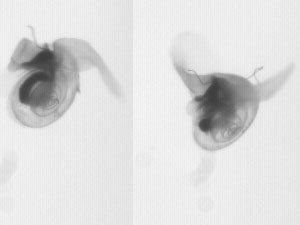Tiny sea snail swims by flapping its 'wings' like an insect, US scientists discover
The discovery of the mollusc's unusual motion could inspire designers creating tiny drones

A species of tiny sea snail navigates the oceans by 'flying' through the water like a bee, American scientists have discovered.
The limacina helicnia, part of the 'sea butterfly' family, was filmed swimming in super-slow-motion by Dr David Murphy, a researcher from the Georgia Institute of Technology.
Analysing the footage, he and his team found the 3mm snail flaps wing-like structures on its sides to move through the water - setting it apart from similar creatures, which tend to use their appendages to paddle their way around the sea.
In a paper detailing their findings, now published in the Journal of Experimental Biology, the team pointed out that the tiny mollusic moves its 'wings' in a characteristic figure-eight pattern, generating lift in much the same way as very small insects who fly through the air.
According to the study, the strange movement is a "remarkable example of convergent evolution," meaning it has evolved similtaneously in completely different organisms.
Speaking to BBC News, Dr Murphy said: "Almost all zooplankton use their swimming appendages like paddles... I was pretty sure that the sea butterfly was going to do something similar."
However, he said he was "really surprised" to find it flapping so gracefully, adding: "It turns out to be more of an honorary insect."
His findings will help scientists understand more about how these unusual creatures behave, but the discovery that the snail uses extreme rotations of its body to achieve the flapping effect could have "implications for micro aerial vehicle (MAV) design," according to the study.
By studying the snail's unique motion, engineers looking to create tiny drones could find some inspiration.
Subscribe to Independent Premium to bookmark this article
Want to bookmark your favourite articles and stories to read or reference later? Start your Independent Premium subscription today.


Join our commenting forum
Join thought-provoking conversations, follow other Independent readers and see their replies
Comments